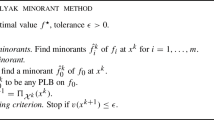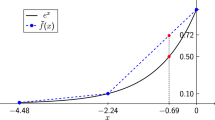Abstract
This work extends the logical benders approach for solving linear programs with complementarity constraints proposed by Hu et al. (SIAM J Optim 19(1):445–471, 2008) and Bai et al. (Comput Optim Appl 54(3):517–554, 2013). We develop a novel interpretation of the logical Benders method as a reversed branch-and-bound search, where the whole exploration procedure starts from the leaf nodes in an enumeration tree. This insight enables us to provide a new framework over which we can combine master problem and cut generation in a single process. It also allows us to diversify the search, leading computationally to stronger cuts. We also present an optimization-based sparsification process which makes the cut generation more efficient. Numerical results are presented to show the effectiveness of this enhanced method. Results are also extended to problems with more complementarity constraints, exceeding those that can be handled by the original method in the cited references.




Similar content being viewed by others
Notes
Notation: \(N_n(0,1)\), refers to n i.i.d. draws from a standard normal distribution; \(U_n(a,b)\), n draws from a uniform distribution in the (a, b) interval, and \(DU(\{a_1,\ldots ,a_m\})\), a uniform draw from the set \(\{a_1,\ldots ,a_m\}\).
We write “worst” within quotes because if this case happens, the cut would have sparsity at most 2, i.e., very sparse.
References
Achterberg, T.: Constraint integer programming. Ph.D. Thesis, Technische University Berlin (2007)
Alvarez, A.M., Louveaux, Q., Wehenkel, L.: A machine learning-based approximation of strong branching. INFORMS J. Comput. 29(1), 185–195 (2017)
Bai, L., Mitchell, J.E., Pang, J.S.: On convex quadratic programs with linear complementarity constraints. Comput. Optim. Appl. 54(3), 517–554 (2013)
Bard, J.F., Moore, J.T.: A branch and bound algorithm for the bilevel programming problem. SIAM J. Sci. Stat. Comput. 11(2), 281–292 (1990)
Belotti, P., Bonami, P., Fischetti, M., Lodi, A., Monaci, M., Nogales-Gomez, A., Salvagnin, D.: On handling indicator constraints in mixed integer programming. Comput. Optim. Appl. 65(3), 545–566 (2016)
Bonami, P., Lodi, A., Tramontani, A., Wiese, S.: On mathematical programming with indicator constraints. Math. Program. 151, 191–223 (2015)
Burdakov, O.P., Kanzow, C., Schwartz, A.: Mathematical programs with cardinality constraints: reformulation by complementarity-type conditions and a regularization method. SIAM J. Optim. 26(1), 397–425 (2016)
Candes, E.J., Wakin, M.B., Boyd, S.P.: Enhancing sparsity by reweighted \(\ell _1\) minimization. J. Fourier Anal. Appl. 14(5–6), 877–905 (2008)
Feng, M., Mitchell, J.E., Pang, J.S., Shen, X., Wächter, A.: Complementarity formulations of \(\ell _0\)-norm optimization problems. Pac. J. Optim. 14(2), 273–305 (2018)
Fischer, T., Pfetsch, M.E.: Branch-and-cut for linear programs with overlapping SOS1 constraints. Math. Program. Comput. 10(1), 33–68 (2018)
Fischetti, M., Monaci, M.: Backdoor branching. INFORMS J. Comput. 25(4), 693–700 (2013)
Fischetti, M., Monaci, M.: Exploiting erraticism in search. Oper. Res. 62(1), 114–122 (2014)
Fletcher, R., Leyffer, S.: Solving mathematical programs with complementarity constraints as nonlinear programs. Optim. Methods Softw. 19(1), 15–40 (2004)
Gomes, C.P., Kautz, H., Sabharwal, A., Selman, B.: Satisfiability solvers. In: van Harmelen, F., Lifschitz, V., Porter, B. (eds.) Handbook of Knowledge Representation, Elsevier, pp. 89–134 (2008)
Gomes, C.P., Selman, B., Kautz, H.A.: Boosting combinatorial search through randomization. In: Proceedings of AAAI/IAAI 1998, p. online. AAAI (1998)
Gurobi Optimization: Inc.: Gurobi optimizer reference manual, 2015. URL: http://www.gurobi. com (2014)
Hooker, J.N., Ottosson, G.: Logic-based Benders decomposition. Math. Program. 96(1), 33–60 (2003)
Hu, J., Mitchell, J.E., Pang, J.S.: An LPCC approach to nonconvex quadratic programs. Math. Program. 133(1–2), 243–277 (2012)
Hu, J., Mitchell, J.E., Pang, J.S., Bennett, K.P., Kunapuli, G.: On the global solution of linear programs with linear complementarity constraints. SIAM J. Optim. 19(1), 445–471 (2008)
Hu, J., Mitchell, J.E., Pang, J.S., Yu, B.: On linear programs with linear complementarity constraints. J. Glob. Optim. 53(1), 29–51 (2012)
Huang, J.: The effect of restarts on the efficiency of clause learning. In: Proceedings of IJCAI-07, pp. 2318–2323 (2007)
Ibaraki, T.: Complementary programming. Oper. Res. 19(6), 1523–1529 (1971)
Ibaraki, T.: The use of cuts in complementary programming. Oper. Res. 21(1), 353–359 (1973)
IBM ILOG: Cplex. Book 12.2 User’s Manual (2010)
Jeroslow, R.G.: Cutting-planes for complementarity constraints. SIAM J. Control Optim. 16(1), 56–62 (1978)
Jeroslow, R.G.: The polynomial hierarchy and a simple model for competitive analysis. Math. Program. 32(2), 146–164 (1985)
Karzan, F.K., Nemhauser, G.L., Savelsbergh, M.W.: Information-based branching schemes for binary linear mixed integer problems. Math. Program. Comput. 1(4), 249–293 (2009)
Leyffer, S., López-Calva, G., Nocedal, J.: Interior methods for mathematical programs with complementarity constraints. SIAM J. Optim. 17(1), 52–77 (2006)
Lodi, A., Zarpellon, G.: On learning and branching: a survey. TOP 25(2), 207–236 (2017)
Luo, Z.Q., Pang, J.S., Ralph, D.: Mathematical Programs with Equilibrium Constraints. Cambridge University Press, Cambridge (1996)
Williams, R., Gomes, C.P., Selman, B.: Backdoors to typical case complexity. In: Proceedings of IJCAI-2003, pp. 1173–1178 (2003)
Yu, B.: A branch and cut approach to linear programs with linear complementarity constraints. Ph.D. Thesis, Department of Mathematical Sciences, Rensselaer Polytechnic Institute, Troy, NY 12180 USA (2011)
Yu, B., Mitchell, J.E., Pang, J.S.: Solving linear programs with complementarity constraints using branch-and-cut. Math. Program. Comput. (2018). https://doi.org/10.1007/s12532-018-0149-2
Author information
Authors and Affiliations
Corresponding author
Additional information
Publisher's Note
Springer Nature remains neutral with regard to jurisdictional claims in published maps and institutional affiliations.
The work of Jara-Moroni was partially funded by the CONICYT PFCHA/DOCTORADO BECAS CHILE/2013-72140466 and the National Science Foundation under grant CMMI-1334639.
The work of Mitchell was funded by the National Science Foundation under grants CMMI-1334327 and DMS-1736326. The work of Pang was based on research supported by the Air Force Office of Scientific Research under grant FA9550-15-1-0126 and the National Science Foundation under grant CMMI-1402052.
The work of Wächter was funded by the National Science Foundation under grant CMMI-1334639.
Rights and permissions
About this article
Cite this article
Jara-Moroni, F., Mitchell, J.E., Pang, JS. et al. An enhanced logical benders approach for linear programs with complementarity constraints. J Glob Optim 77, 687–714 (2020). https://doi.org/10.1007/s10898-020-00905-z
Received:
Accepted:
Published:
Issue Date:
DOI: https://doi.org/10.1007/s10898-020-00905-z




